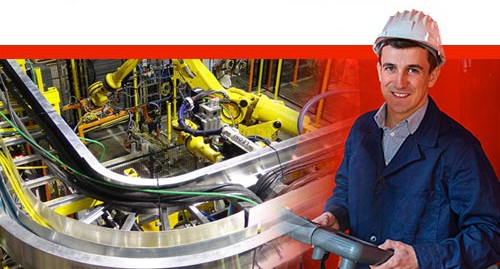For over 50 years, we have dedicated ourselves to providing Industry with best in class wire management solutions and to helping solve mission critical issues.
The needs of today’s schools and universities are changing fast. When it comes to anticipating and meeting those needs, MonoSystems is in a class of its own.
For the past five decades, we’ve made it our business to offer more value to our partners, which in turn provides greater value to their customers.
The Future of Ladder Cable Tray Innovation in Electrical Infrastructure
The ladder cable tray system has emerged as a critical component in modern electrical infrastructure, providing efficient pathways for cable management. According to a recent report from MarketsandMarkets, the global cable tray market is projected to reach USD 6.5 billion by 2027, growing at a CAGR of 6.2% from 2022. This growth underscores the increasing demand for reliable and innovative solutions in electrical installations. As industries evolve and adopt advanced technologies, the need for alternatives in ladder cable tray configurations becomes paramount. These innovations are spurred by factors like the expanding renewable energy sector and the rise of data centers, which necessitate improved cable management systems to handle complex wiring requirements. Exploring the future of ladder cable tray innovations will not only enhance the efficiency and safety of electrical systems but also contribute significantly to sustainability efforts across various sectors.

Emerging Trends in Ladder Cable Tray Design and Materials
The ladder cable tray sector is undergoing significant innovation, driven by emerging trends in design and materials. With the U.S. cable tray market forecasted to expand from USD 5.33 billion in 2023 to USD 9.09 billion by 2032, the demand for efficient and sustainable cable management solutions continues to rise, with a compound annual growth rate (CAGR) of 6.12%. Materials such as steel, aluminum, and stainless steel dominate the market due to their strength and durability, but the adoption of advanced composites, including fiberglass reinforced plastic (FRP), is gaining traction. The FRP cable tray market alone is projected to grow to $696.78 million by 2032, reflecting a CAGR of 8.36%.
Innovative designs, such as swaged and welded ladder configurations, are becoming essential in optimizing load-bearing capacities while reducing material usage. As businesses prioritize sustainability, the integration of energy-efficient production techniques and recyclable materials into cable tray systems will be vital.
Tip: When selecting a cable tray for your project, consider not only the material strength but also the environmental impact and total lifecycle cost of the system.
Tip: Keep an eye on emerging technologies in cable management, as they can offer enhanced safety and efficiency, leading to long-term savings and better system reliability.
Impact of Technological Advancements on Electrical Infrastructure
As we look towards the future of ladder cable tray innovation within electrical infrastructure, it becomes increasingly clear that technological advancements are reshaping how we approach energy distribution and consumption. The recent surge in electric vehicle (EV) adoption serves as a prime example, highlighting the need for comprehensive charging infrastructure.
Research indicates that every 10% increase in private charging station installation corresponds to a 4% boost in EV market share. This directly illustrates how infrastructure upgrades can accelerate the transition to sustainable transportation solutions, effectively reducing our reliance on fossil fuels.

Sustainability Practices in Ladder Cable Tray Manufacturing
As the demand for sustainable practices in construction and electrical infrastructure grows, the ladder cable tray manufacturing industry is evolving to meet these expectations. According to a recent report by MarketsandMarkets, the global cable tray market is projected to reach over $4 billion by 2026, with a notable shift towards eco-friendly materials and production methods. Manufacturers are increasingly adopting recyclable materials such as aluminum and polycarbonate, which not only reduce environmental impact but also enhance the longevity and durability of cable trays.
Furthermore, initiatives such as energy-efficient manufacturing processes are gaining traction. The Carbon Trust estimates that up to 30% of industrial energy can be saved through improved efficiency measures, prompting ladder cable tray manufacturers to invest in greener technologies. Additionally, sustainable practices, including the reduction of waste during production and the implementation of circular economy principles, are becoming integral to the industry. This movement not only supports environmental goals but also aligns with regulatory changes aimed at reducing the carbon footprint of electrical infrastructure projects.
The Future of Ladder Cable Tray Innovation in Electrical Infrastructure
Integration of Smart Technology in Cable Tray Systems
The integration of smart technology in cable tray systems is set to revolutionize the landscape of electrical infrastructure. As reported by MarketsandMarkets, the smart cable tray market is projected to grow from USD 1.5 billion in 2021 to USD 3.2 billion by 2026, demonstrating a significant annual growth rate of over 16%. This rapid expansion is largely driven by the increasing demand for enhanced energy efficiency and real-time monitoring capabilities in industrial settings.
Smart cable trays are now being equipped with IoT sensors that allow for live data collection regarding temperature, humidity, and load conditions. This data facilitates predictive maintenance, enabling facility managers to address potential issues before they escalate into costly failures. According to a report by Technavio, integrating smart technologies into electrical infrastructure can reduce operational costs by up to 30%, benefitting both large-scale industrial applications and smaller enterprises.
Furthermore, the environmental impact of smart cable trays cannot be overlooked. With sustainable practices becoming a priority, these innovative systems are designed to optimize power consumption and reduce waste. They enable better cable management, ensuring the longevity of electrical components while minimizing downtime. A recent study indicates that implementing smart cable trays can lead to a 20% reduction in energy usage, aligning with global sustainability goals and making them indispensable for future-ready electrical infrastructure.
The Future of Ladder Cable Tray Innovation in Electrical Infrastructure - Integration of Smart Technology in Cable Tray Systems
| Feature | Description | Benefits | Challenges |
|---|---|---|---|
| Smart Monitoring Systems | Integration of sensors to monitor cable health and environmental conditions. | Early detection of issues, reduced downtime, improved safety. | High initial investment and complexity of setup. |
| Automated Cable Management | Systems that automatically manage and reroute cables as needed. | Enhanced efficiency, optimized space utilization. | Potential technical issues and maintenance requirements. |
| Data Analytics Integration | Using AI and machine learning to analyze data from cable systems. | Improved decision-making and predictive maintenance. | Data privacy concerns and the need for skilled personnel. |
| Modular Design | A design approach that allows for easy expansion and reconfiguration. | Flexibility for future upgrades and scalability. | Potential high costs in redesigning existing systems. |
| Sustainability Features | Use of recyclable materials and energy-efficient designs. | Reduced environmental impact and compliance with regulations. | Higher costs for sustainable materials and technologies. |
Future Challenges and Opportunities in Ladder Cable Tray Innovation
The future of ladder cable tray innovation is poised to meet significant challenges while also unlocking various opportunities in electrical infrastructure. As advancements in technology and sustainability continue to reshape the industry, companies will need to adapt their designs to accommodate more complex electrical needs. According to a recent report by Persistence Market Research, the cable tray market is projected to reach USD 93 billion by 2028, highlighting an increasing demand for efficient cable management solutions.
One major challenge lies in meeting the stricter regulatory standards for fire safety and material sustainability. Industry experts recommend investing in fire-resistant materials and exploring the use of recycled materials to not only comply with these regulations but also to appeal to environmentally conscious clients. Moreover, businesses should stay ahead of market trends by embracing digital technologies that enhance monitoring and maintenance processes, leading to greater operational efficiency.
Tip: Regularly assess and update your cable tray systems to incorporate the latest materials and technologies that enhance safety and efficiency. Engaging with suppliers who prioritize innovation can help ensure that your infrastructure remains competitive and future-proof. As these innovations develop, ladder cable tray systems will play a crucial role in supporting the evolving landscape of electrical infrastructure.

Related Posts
-

Ultimate Checklist for Choosing the Best Metal Cable Tray for Your Project Needs
-

Mastering the Best Cable Tray Desk for Ultimate Workspace Organization
-

Emerging Technologies Shaping Best Cable Tray Systems for 2025 and How to Optimize Your Setup
-

Understanding Import and Export Certifications for the Best Stainless Steel Cable Tray
-

7 Essential Tips for Choosing the Right Cable Tray Systems for Your Project
-

Ultimate Guide to Electrical Cable Trays: Optimizing Efficiency and Safety in Modern Installations


